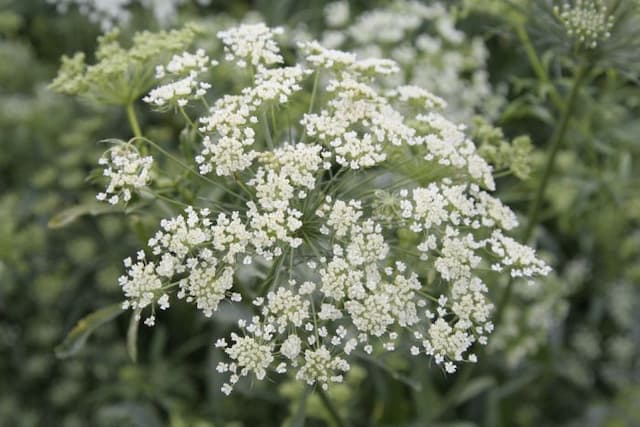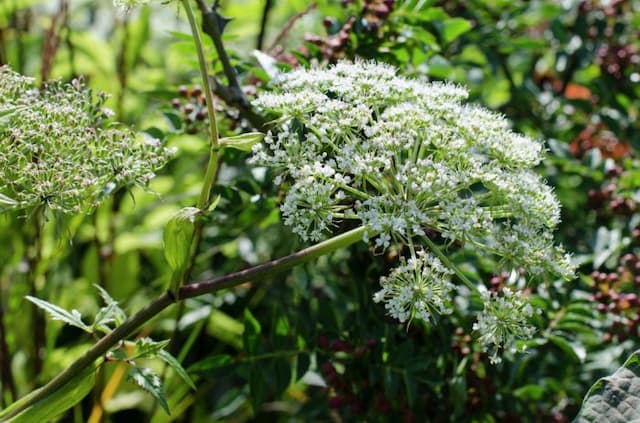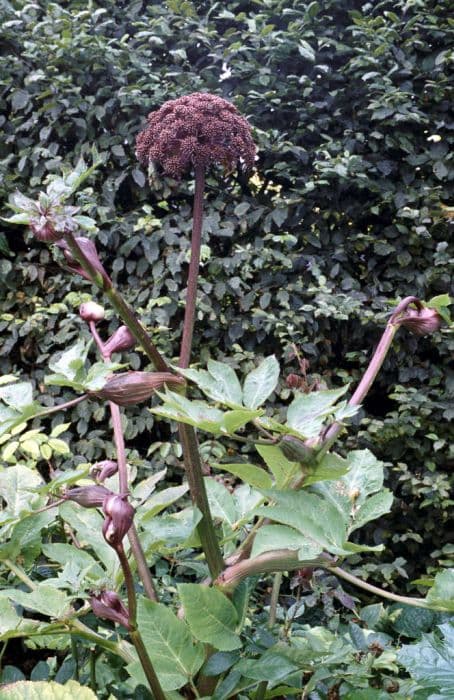Purple Dragon Carrot Daucus carota 'Purple Dragon'

ABOUT
The 'Purple Dragon' carrot is a captivating variety notable for its striking, deep purple exterior skin which gracefully encases a vibrant, orange core. The contrast between the dark external layer and the bright interior adds an aesthetically pleasing and unexpected twist to the usual appearance of this root vegetable. The skin has an earthy tone and a smooth texture to the touch. Upon slicing the carrot, one can appreciate the radiant orange hue at the center that creates a beautiful visual when the carrot is cut into disks or matchsticks. The foliage of the 'Purple Dragon' carrot is equally attractive, with feathery green leaves that sprout from the top of the root, creating a bushy canopy above the soil. This leafy green top is an indicator of the carrot's freshness and vigor. The lacy foliage can be quite lush and is often used as a garnish in culinary presentations for its aesthetic appeal, as well as its subtle, herbaceous flavor. In terms of taste, 'Purple Dragon' carrots are known for their sweet flavor, with a hint of spiciness that is not usually found in the more common orange varieties. The texture is crisp and snappy when raw, making it ideal for fresh eating, such as in salads or as a crunchy snack. When cooked, the carrot softens, but still retains a tender firmness, and the sweetness is enhanced, making it a versatile ingredient in both savory and sweet dishes. When harvested, the purple skin may sometimes fade to reveal more of the brilliant orange underneath, especially after washing or peeling, but this color transition does not affect the taste or nutritional value of the carrot. Overall, the 'Purple Dragon' carrot is not only a visual treat but also a delightful addition to the palate that offers the same nutrition and health benefits commonly associated with carrots.
About this plant
 Names
NamesFamily
Apiaceae
Synonyms
Purple Dragon Carrot, Purple Dragon
Common names
Daucus carota 'Purple Dragon'.
 Toxicity
ToxicityTo humans
Purple Dragon carrot is not toxic to humans. In fact, it is a cultivated variety of carrot that is edible and nutritious, like other common carrots. Ingesting it does not lead to poisoning, as it is grown for culinary use and can be consumed safely like other carrot varieties.
To pets
Purple Dragon carrot is not toxic to pets. It is simply a variety of carrot, which can be safely consumed by animals like dogs and horses, among others. Ingesting this plant should not cause any symptoms of poisoning in pets, and it is often considered a healthy treat for them in moderation. However, as with any food item not typically part of an animal's natural diet, it should be introduced slowly and in small quantities to avoid potential digestive upset.
 Characteristics
CharacteristicsLife cycle
Biennials
Foliage type
Deciduous
Color of leaves
Green
Flower color
White
Height
1-3 feet [30-90 cm]
Spread
0.5-1 feet [15-30 cm]
Plant type
Herb
Hardiness zones
3-11
Native area
Europe
Benefits
 General Benefits
General Benefits- Culinary versatility - Purple Dragon carrot can be eaten raw, cooked, or juiced, adding both color and flavor to a variety of dishes.
- Nutrition - Rich in vitamins and antioxidants, particularly anthocyanins which are responsible for its purple hue.
- Garden aesthetics - The striking purple color adds visual interest and diversity to vegetable gardens and ornamental plantings.
- Pollinator attraction - When allowed to flower, the plant attracts beneficial insects such as bees, which are vital for pollination in the garden.
- Soil improvement - As a root vegetable, it can help break up compact soils, improving soil structure and health.
- Educational value - Can be used to teach about plant biology, genetics (color inheritance), and healthy eating habits.
- Market demand - Unique heirloom varieties like Purple Dragon carrot can fetch higher prices at markets due to their distinctive appearance and taste.
- Easy to grow - Adaptable to a range of climates and soil types, making it accessible to many gardeners.
- Crop rotation - Being a root vegetable, it is an ideal crop for rotating with leaf and fruit crops to maintain soil health and minimize pests and diseases.
- Storage - When harvested, Purple Dragon carrots store well, providing a long-lasting vegetable option through the fall and winter months.
 Medical Properties
Medical Properties- Rich in antioxidants: Purple Carrot may offer antioxidant properties due to high levels of anthocyanins.
- Eye health support: Contains beta-carotene which the body converts to vitamin A, crucial for vision.
- Anti-inflammatory effects: Due to its phytonutrients, it may help in reducing inflammation.
- Digestive health: High in dietary fiber, supporting digestive system function.
- Cardiovascular support: Antioxidants and fiber in Purple Carrot may promote heart health.
 Air-purifying Qualities
Air-purifying QualitiesThis plant is not specifically known for air purifying qualities.
 Other Uses
Other Uses- The leaves of the carrot can be used as a natural dye for fabrics, giving them a subtle, earthy color.
- The finely chopped carrot tops can serve as an herb-like garnish, adding a fresh and slightly bitter taste to dishes.
- Creative gardeners use the ornamental 'Purple Dragon' carrots in floral arrangements for their unique color and texture.
- Dried and ground carrot seeds from this variety can be used in homemade spice blends or as a substitute for cumin or caraway.
- The root can be pureed to make a natural food coloring for pastries, such as macarons, to add a purple hue without artificial dyes.
- Fermented carrot roots can be used to make a tangy, probiotic-rich food similar to sauerkraut or pickles.
- The foliage of 'Purple Dragon' carrots can be woven into a natural mesh for garden use, such as supporting climbing plants.
- Roasted and ground 'Purple Dragon' carrot roots can be used as an alternative to coffee for a caffeine-free, slightly sweet drink.
- The fibrous nature of the carrot roots makes them useful as a biodegradable pot scrubber when cut into thick slices.
- When planted in a dense pattern, 'Purple Dragon' carrots can serve as a living mulch to reduce weed growth and retain soil moisture.
Interesting Facts
 Feng Shui
Feng ShuiThe Purple Carrot is not used in Feng Shui practice.
 Zodiac Sign Compitability
Zodiac Sign CompitabilityThe Purple Carrot is not used in astrology practice.
 Plant Symbolism
Plant Symbolism- Concealed Beauty: The 'Purple Dragon' carrot, often simply known as the purple carrot, has a striking purple exterior that hides its orange interior, symbolizing depth and mystery beyond outward appearances.
- Health and Nourishment: Carrots are widely known for their nutritional benefits, including high levels of beta-carotene. This association extends to the purple carrot, reflecting well-being and the importance of taking care of one's health.
- Fertility and Abundance: As a root vegetable that proliferates under the soil, carrots often symbolize fertility and the ability to create life, relating to the resourcefulness and productivity of the earth.
- Grounding: The fact that carrots grow underground can be symbolic of being grounded or having a solid foundation. This aspect of the purple carrot may represent staying connected to one's roots and stability.
 Water
WaterPurple Dragon carrots require consistent moisture, so they should be watered deeply once or twice a week, providing 1 to 1.5 inches of water each time depending on weather conditions. Ensure the soil is kept moist but not waterlogged. Water at the base of the plant to minimize wetting the foliage which can lead to fungal diseases. During periods of high heat or dry winds, additional watering may be required to maintain soil moisture. The actual amount of water needed can vary based on soil type and weather, but in general, aim for about 1 gallon per square foot per week.
 Light
LightPurple Dragon carrots thrive in full sunlight, requiring a minimum of 6 hours of direct sunlight per day to grow properly. Select a spot in the garden where they receive unobstructed sunlight throughout the day for optimal development. Avoid areas with heavy shade as this can impair root development and reduce the sweetness of the carrots.
 Temperature
TemperaturePurple Dragon carrots grow best in cooler temperatures between 60°F and 75°F, but they can withstand temperatures as low as 40°F and as high as 85°F. They are frost-tolerant and can be planted early in the season. Consistency is key, as extreme fluctuations in temperature can affect their growth and flavor profile.
 Pruning
PruningPruning, or in the case of Purple Dragon carrots, thinning, is necessary to prevent overcrowding, which can result in smaller roots. Thin the seedlings when they're about 2 inches tall, leaving 1 to 2 inches of space between plants. The best time to thin carrots is in the late afternoon or on a cloudy day to prevent sun scald on the exposed roots.
 Cleaning
CleaningAs needed
 Soil
SoilThe Purple Dragon carrot prefers a well-draining soil mix rich in organic matter with a pH between 6.0 and 7.0. A combination of garden soil, compost, and perlite will support healthy growth.
 Repotting
RepottingPurple Dragon carrots do not require repotting as they are annual plants grown for their edible roots and are harvested at the end of the growing season.
 Humidity & Misting
Humidity & MistingPurple Dragon carrots are adaptable to outdoor conditions and do not require specific humidity levels, thriving in average outdoor humidity.
 Suitable locations
Suitable locationsIndoor
Grow 'Purple Dragon' carrot in deep pots with ample light and well-drained soil.
Outdoor
Plant 'Purple Dragon' carrot in sunny spot with loose, fertile soil.
Hardiness zone
Purple Dragon carrot is best grown in USDA zones 3-10.
 Life cycle
Life cycleThe common name for Daucus carota 'Purple Dragon' is Purple Dragon Carrot. The life cycle begins with seed germination, which occurs when soil temperatures reach between 7-30°C (45-85°F), typically in the spring. Once the seeds sprout, the plant enters the vegetative stage, developing feathery green foliage and a strong root system; the root is the part of the plant that will become the carrot. After several weeks to months of growth, depending on conditions, the carrot root matures and reaches a harvestable size, characterized by its deep purple color. If left unharvested, the plant may enter its second year to flower and produce seeds; it produces white, lacy flowers arranged in umbels that attract pollinators. Upon pollination, seeds develop and, once matured, can be collected for the next planting or left to self-sow, thus starting a new life cycle.
 Propogation
PropogationPropogation time
Spring to Summer
Propogation: Purple Dragon carrots, known for their unique deep purple color, are typically propagated through seed since they are a root vegetable. The best time to sow carrot seeds is in early spring, as soon as the soil can be worked. To ensure successful germination, the soil temperature should be between 45 to 85 degrees Fahrenheit (7 to 29 degrees Celsius). Sowing is commonly done directly in the garden bed, as carrots do not transplant well due to their delicate taproot system. Seeds should be planted about 1/4 inch (about 6 millimeters) deep in loose, well-drained soil. Carrot seeds are tiny, so they need to be sown sparingly or thinned out after germination to give each carrot room to grow. After sowing, it's important to keep the soil consistently moist until seedlings emerge. To maintain an optimal growing environment, gardeners might cover the soil with a thin layer of vermiculite or fine compost to retain moisture.








